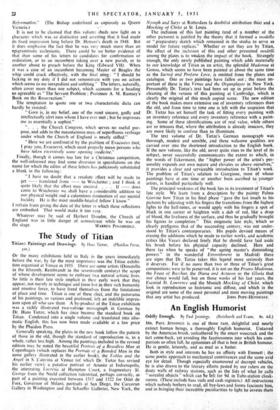The Study of Titian
OF the many exhibitions held in Italy in the years immediately before the war, by far the most impressive was the Titian exhibi- tion organised at Venice in 1935. There arc some artists (Donatello in the fifteenth, Rembrandt in the seventeenth century) the scope of whose development seems to embrace two natural artistic lives. So little is their late style implicit in their early work that they appear, not merely in technique and form but in.their rich humanity and emotive force, to have freed themselves from the limitations of place and time. Titian is one of these elect, and the panorama of his paintings. so various and profound, left an indelible impres- sion upon all who saw them A by-product of the Titian exhibition was a richly illustrated two-volume monograph in German by Dr. Hans Tietze, which has since become the standard book on Titian. Condensed into a single volume and translated into idio- matic English. this has now been made available at a low price by the Phaidon Press.
Generally speaking, the plates in the new book follow the pattern of those in the old, though the standard of reproduction is, as a whole, rather less high. Among the paintings included in the revised edition may be noted the beautiful Portrait of a Beardless Man at Copenhagen (which replaces the Portrait of a Bearded Man in the same gallery illustrated in the earlier book). the Tobias and the Angel in S. Caterina at Venice (of which Dr. Tietze has revised his earlier view), a putative portrait of Ariosto at Indianapolis, the interesting Lucretia at Hampton Court, a fragmentary St. George from the Neeld collection (identified. perhaps correctly, as part of a painting executed between 1517 and 1522 for Odet de Foix, Governor of Milan), portraits at San Diego. the Corcoran Gallery in Washington and the Schaeffer Galleries. New York, the Nymph and Satyr at Rotterdam (a doubtful attribution this) and a Mocking of Christ at St. Louis. The Inclusion of this last painting (and of a number of the other pictures) is justified by the theory that it formed a ',laden° or " preparatory sketch which remained in the studio to serve as model for future replicas." Whether or not they are by Titian, the effect of the inclusion of this and other presumed modern among the plates is to Weaken the impact of the book. Strangely enough, the only newly published painting which adds materially to our knowledge of Titian as an artist, the splendid Madonna at Genoa, which seems to have been painted at about the same time as the Sacred and Profane Love, is omitted from the plates and catalogue. One or two paintings have fallen out ; the most im- portant of these is the Venus and the Organ player in New York. Presumably Dr. Tietze's text had been set up in print before the cleaning of the version Of this painting at Cambridge, which is clearly the original of this much copied scene. The new edition of the book makes more extensive use of inventory references than the old, and from time to time one is left with the suspicion that Dr. Tietze has set himself the task of fitting every painting with an inventory reference and every inventory reference with a paint- ing. Some of these identifications are of real value, while others are so tenuous that, where the attribution is already insecure, they are more likely to confuse than to illuminate. The text volume of Dr. Tietze's German monograph was thorough, modest and sensible, and these welcome qualities are carried over into the shortened introduction to the English book. If the new volume, like the old, never quite rises to the level of its subject, never successfully communicates the extent to which, in the words of Eckermann, the " higher power of the artist's per- sonality expands our own nature and elevates us above ourselves," it provides a clear and serviceable introduction to Titian's work. The problem of Titian's relation to Giorgione, most of whose paintings have at one time or another been ascribed to younger artists, is handled particularly well.
The principal weakness of the book lies in its treatment of Titian's late style. We learn from a description by the painter Palma Giovine how Titian in his final phase " gave the last touch to his pictures by adjusting with his fingers the transitions from the highest lights to the half-tones, or would apply with his fingers a spot of blank in one corner or heighten with a dab of red, like a drop of blood, the liveliness of the surface, and thus he gradually brought his figures to completion." This enigmatic late style, which so clearly prefigures that of the succeeding century. was not under- stood by Titian's contemporaries. His pupils devised means of erasing the additions which he made to earlier works, and academic critics like Vasari declared freely that he should have laid aside his brush before his physical capacity declined. Here and there (as when he speaks of "the ageing master's diminishing powers" in the wonderful Entombment in Madrid) there are signs that Dr. Tietze takes this legend more seriously than it deserves. For if no more than two or three of Titian's great compositions were to be preserved, it is not on the Pesaro Madonna, the Feast of Bacchus, the Diana and Actaeon or the Gloria that our choice would fall, but on those works of his last years, the Escorial St. Lawrence and the Munich Mocking of Christ. which look in reproduction so histrionic and diffuse, and which in the original are some of the most personal and most moving paintings






































 Previous page
Previous page